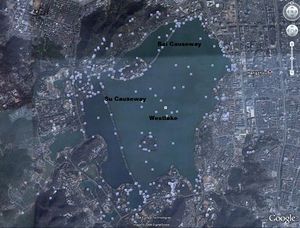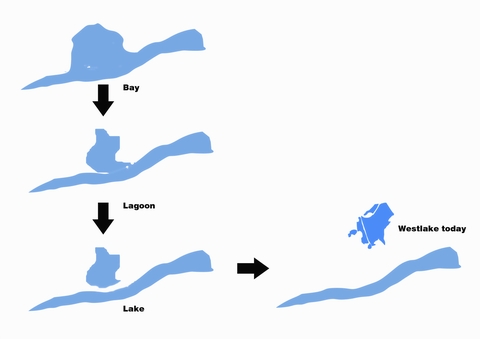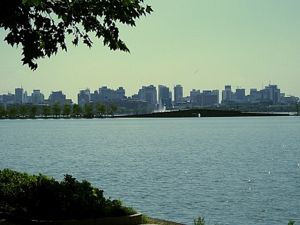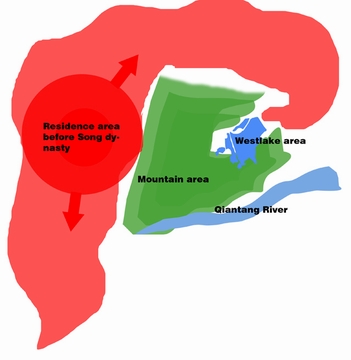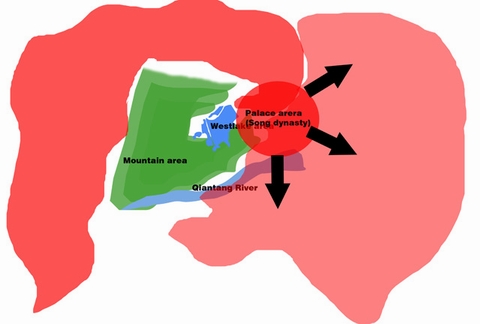Hangzhou
weave a new memory for Westlake (Hangzhou, China)
Rationale: Why is this case study interesting?
It has never been such a story and would never be such a story which could clarify the relationship between human, city, life and nature more expressively in Chinese history. The story is deposited by struggles, hardship, repetitions, as well as joy, triumph and harmony.
Westlake, located in center of the city Hangzhou, boast one of the most prominent scenic spots in China. The coexistence of the city and the lake has gone through more than thousand years. The lake is surrounded by mountains from three sides and face with the dense urban construction on eastside. In this senses, westlake and the adjacent mountain played a critical role in prevent the sprawl and actually become the last oasis without being perished.
In 2002, the third time of dredging and comprehensive protection project of Westlake. Hangzhou China, was initialized. Superficially, it was only one of thousands dredging projects in the history of Westlake. However, considering the pretermission during the last 300 years, the quality of lake existence, the symbiotic relationship between human and lake had deteriorated into a severe condition, this project carried more commissions both ecologically, culturally and pragmatically.
Author's perspective
- What theoretical or professional perspective do you bring to the case study?
Landscape and/or urban context
- Biogeography, cultural features, overall character, history and dynamics
Illustration: Map; sketches; short descriptive analyses
West lake is located in southeast china, north to the subtropical region.The whole area of Westlake covers 6.38km2, Annual run-off is around 14,000,000m3 while freuquncy of water substitution is once per year.
Trace back to the origin and history of West lake, the whole span of the lake falls into two phases with the former one attribute to no more than a natural evolution of a lake——from a bay nearby the Yangzi delta, to a lagoon and finally enclosed by alluvial clay from Qiantang river. This is approximately the phenotype of the Westlake we are familiar with. However, if evolution was straightly going through, the lake should have been swallowed by the sands and sendiment from streams which connect Qiantang river and Westlake, then finally be converted into farm land or swamp. However, the settlement of inhabitants in this area absolutely changed the fate of Westlake, as a result unravel the second phase of Westlake——from a natural lake to an artificial lake that is protected by dam and dredged consistently. Due to the need of drinking water for the increasing population, whereas all the water from river, even from the wells deeply digged in this region are all contaminated with the salty water from east China sea, the residents had to rely on the precious eligible water from Westlake. The coexistence relationship was reinforced with the establishment of Hangzhou as a capital city of China in Song dynasty.The political decision obviously place westlake in a more significant status and therefore, the revitalisation of westlake became the rountine exploit of each dynasty and each emperor either in aesthetical way or ecological way.
The evolution of Westlake
Cultural/social/political context
- Brief explanation of culture, political economy, legal framework
Illustration: Bullet points, image, background notes
History
- How did the area/project/plan at the focus of the case study evolve?
Illustration: Table or time line
Spatial analysis of area/project/plan
- What are the main structural features?
- How has it been shaped? Were there any critical decisions?
Illustration: Map/diagram/sketches photos and background notes
Core Questions Working Group Nature Conservation / Water
What is the role of user groups?
What is the role of the city?
The coexistence of city and lake is pretty striking in this case. Initially, the lake served as a functional element for the city with which development, the lake is no longer used as a source of drinking water.The lake, with the mountain beside the lake, are enclosed by the city and actually doomed to be dependend on the development of the city.
How do urban and natural structures interact?
Westlake is surrounded by mountain from three sides. To this point, only one side was left to attach the border of "urban" structure. The east border of west lake remians a tough problem for all the designers to cope with.The natural shore from the other three sides, which dotted with numerous amazing senic spot and fauna shed with beatufifully shaped peaks, dimmed the concrete forest along the east side. The skyscrapers, build up were just one lane away from east side of Westlake without any shield.This problem remains unsettled during this project,however,we anticipate in the next 10 years,municiple government of Hangzhou can take measure to prevent the city sprawling by either demolish certain existed buildings or draft relative regulation to control the building of highrises.
What is the role of water?
Compared to the city, which is the leading domain in the 'coexistence' relationship. the water is changed by the activities of human being. Nowadays, the role of the lake is purely for recreation, which boasts as the most famous scenery spot in China. It is because of the significance of the culture heritage it carries that make the existence of the lake more prominent than ecological means.
What is the evolution of the urban relation between humans and nature?
The first span of Westlake is non-artifical, which was kept until people started to settle down in the lake region, the place supposed to be unsuitable to live on. During the second span of Westlake, due to the need of edible water at first, and the aesthetic need later after the establishment of capital city of Hangzhou, which obviously was a bounce-back to the need of edible water for a even larger population plus the daily use for the emperor,the dredging project is never ended because of the nature of Westlake, the "human" plays a leading role in deciding the fate of Westlake.
The chronicle of revitalization project in the chinese history
Year Dynasty Measure 766-779 Tang Six wells were digged to channel the water from westlake to the inner city in order to offer the edible water to the inhabitants in Hangzhou
around 822 Tang A dam was builded to protect westlake from invading, the water from westlake started to be used in irrigation, which is crucial to the farming in this area
around 907 WuDai (five dynasties period) Strengthen the Dreding up to prevent the stagnation, Yong Jin pond was channeled to connect the Westlake and Grand canal
1007 Song revitalation project
1021 Song Fishing was forbidden to protect the stability of the ecological system
1060 Song South Well was digged to supplement the eligible water source for inhabitants
1089 Song Dredging project, the removed soil was reused to build a causeway all across the river, and was named after the project leader, the famous accomplished politician, artist, poet, Su shi (Su causeway). Three stone pergodas were also established in the center of the lake to mark the boundary of fishing forbidden region. This revitalation project was claimed as the most succeesful project in the history and therefore build a example for the following steps for its triumph on both ecological and aesthetic aspects.
1165-1173 South Song rebuild the "Six wells"
1247 South Song remove the water plants (Lotus),which stagnated the water exchange between lake and other channels
1456 Ming two flood gates were build to control the water level
Ming transportation system was established to ease the process of dredging
1505-1508 Ming demolish around 1000qm farming land to broaden the lake, the soil was reused to reinfoce Su causeway,besides, a new causeway was build and again named after the project leader, Yang Minyin( Yang causeway).
1607 Ming dredge the river and a dam was builded inside the river (the scenic spot lake inside lake was then established)
1809 Qin Dreding, island "ruangongdun" was built
1864-1876 Qin Dreding buro was established,which was in charge of the annual dredging
In the very begining when people and the nature(Westlake and the adjacent mountain area) start to contact, they are limited to their own circle, the city is not close to the lake. After Song dynasty, the interaction became strong due to the demand of edible water for booming city development.
Afterwards, with the economic development, the center of the city moved more close to the lake and finally swallowed all the area around the lake and mountain, which is a traditional ideal mode of chinese landscape.
Analysis of program/function
- What are the main functional characteristics?
- How have they been expressed or incorporated?
Illustration: Map/diagram/sketches photos and background notes
Analysis of design/planning process
- How was the area/project/plan formulated and implemented?
- Were there any important consultations/collaborations?
Illustration: Map/diagram/sketches photos and background notes
Analysis of use/users
- How is the area/project/plan used and by whom?
- Is the use changing? Are there any issues?
Illustration: Map/diagram/sketches photos and background notes
Future development directions
- How is the area/project/plan evolving?
- Are there any future goals?
Illustration: Map/diagram/sketches photos and background notes
Peer reviews or critique
- Has the area/ project/plan been reviewed by academic or professional reviewers?
- What were their main evaluations?
Pleas add references, quotes...
Points of success and limitations
- What do you see as the main points of success and limitations of the area/project/plan?
Illustration: Summary table
What can be generalized from this case study?
- Are there any important theoretical insights?
Short statement plus background notes
Which research questions does it generate?
Short statement plus background notes
Image Gallery
- Yourimage.jpg
your image text
- Yourimage.jpg
your image text
- Yourimage.jpg
your image text
- Yourimage.jpg
your image text
- Yourimage.jpg
your image text
- Yourimage.jpg
your image text
- Yourimage.jpg
your image text
- Yourimage.jpg
your image text
- Yourimage.jpg
your image text
References
Please add literature, documentations and weblinks
About categories: You can add more categories by copying the tag and filling in your additional categories


